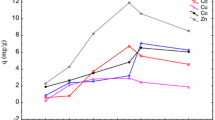Abstract
Ag+ biosorption by an industrial strain of Saccharomyces cerevisiae was investigated. Older (96 h old) biomass had half the biosorption capacity of younger (24 h old) biomass (0.187 and 0.387 mmol Ag+/g dry mass respectively). Comparisons of cell walls isolated from biomass of either age indicated that chemical composition and Ag+ biosorption capacity varied little over the time span examined and that cell walls from either age of culture had small Ag+ biosorption capacities compared to whole cells of a similar age. Silver-containing precipitates were observed both on the cell wall and within the cell, indicating that intracellular components sorbed Ag+. The concentration of these precipitates within the cell appeared visually to decrease with age in Ag+-exposed cells. Incorporation of l-cysteine into the growth medium resulted in biomass with increased silver biosorption capacities, protein and sulphydryl group content. Increasing the concentration of l-cysteine in the growth medium from 0 to 5.0 mM increased silver biosorption from 0.389 to 0.556 mmol Ag+/g dry mass Isolated cell walls of biomass grown in supplemented media also showed a possible link between silver biosorption capacities, protein and sulphydryl group content. No precipitates were observed in silver-exposed biomass that had been grown in the presence of 5.0 mM l-cysteine.
Similar content being viewed by others
References
Avery SV, Tobin JM (1992) Mechanism of strontium uptake by laboratory and brewing strains of Saccharomyces cerevisiae. Appl Environ Microbiol 58: 3883–3889
Brady D, Stoll AD, Starke L, Duncan JR (1994) Chemical and enzymatic extraction of heavy metal binding polymers from isolated cell walls of Saccharomyces cerevisiae. Biotechnol Bioeng 44: 297–302
Brauckmann BM (1990) Industrial solutions amenable to biosorption. In: Volesky B (ed) Biosorption of heavy metals. CRC Press, Boston, pp 51–64
Cassone A, Kerridge D, Gale EF (1979) Ultrastructural changes in cell wall of Candida albicans following cessation of growth and their possible relationship to the development of polyene resistance. J Gen Microbiol 110: 339–349
Catley BJ (1988) Isolation and analysis of cell walls. In: Campbell I, Duffus JH (eds) Yeast: a practical approach. IRL Press, Oxford, pp 163–183
De Nobel JG, Klis FM, Munnik T, Priem J, Van Den Ende H (1990) An assay of relative cell wall porosity in Saccharomyces cerevisiae, Kluyveromyces lactis and Schizosaccharomyces cerevisiae. Yeast 6: 483–490
Failla ML, Benedict CD, Weinberg ED (1976) Accumulation and Storage of Zn2+ by Candida utilis. J Gen Microbiol 94: 23–36
Gadd GM (1986) The uptake of heavy metals by fungi and yeasts: the chemistry and physiology of the process and applications for biotechnology. In: Eccles H, Hunt S (eds) Immobilization of ions by biosorption. Ellis Horwood, Chichester, pp 135–147
Gadd GM (1990) Heavy metal accumulation by bacteria and other microorganisms. Experientia 46: 834–840
Hamer DH (1986) Metallothionein. Annu Rev Biochem 55: 913–951
Herbert D, Phipps PJ, Strange RE (1971) Chemical analysis of microbial cells. Methods Microbiol 5: 209–344
Hunt S (1986) Diversity of biopolymer structure and its potential for ion-binding applications. In: Eccles H, Hunt S (eds) Immobilisation of ions by biosorption. Ellis Horwood, Chicester, pp 15–46
Ivanov AY, Fomchenkov VM (1992) Electro-physical analysis of the damage to Escherichia coli by silver ions. Mikrobiologiya 61: 464–471
Kierans M, Staines AM, Bennett H, Gadd GM (1991) Silver tolerance and accumulation in yeasts. Biol Metals 4: 100–106
Killick KA (1971) Modification of the composition and structure of the yeast cell wall by culture in the presence of sulfur amino acids. J Bacteriol 106: 931–937
Luef E, Prey T, Kubicek CP (1991) Biosorption of zinc by fungal mycelial wastes. Appl Microbiol Biotechnol 34: 688–692
McMurrough I, Rose AH (1967) Effect of growth rate and substrate limitation on the composition and structure of the cell wall of Saccharomyces cerevisiae. Biochem J 105: 189–203
Mullen MD, Wolf DC, Beveridge TJ, Bailey GW (1992) Sorption of heavy metals by the soil fungi Aspergillus niger and Mucor rouxii. Soil Biol Biochem 24: 129–135
Nieboer E, Richardson DHS (1980) The replacement of the nondescript term “heavy metals” by a biologically and chemically significant classification of metal ions. Environ Pollut Ser B 1: 3–26
Northcote DH, Horne RW (1952) The chemical composition and structure of the yeast cell wall. Biochem J 51: 232–236
Oda Y, Ichida S, Aonuma S, Shibahara T (1988) Interactions of cadmium with yeast mannans. Chem Pharm Bull 36: 2695–2698
Simmons P, Tobin JM, Singleton I (1995) Considerations on the use of commercially available yeast biomass for the treatment of metal-containing effluents. J Ind Microbiol 14: 240–246
Slaughter JC (1988) Nitrogen metabolism. In: Berry DR (ed) Physiology of industrial fungi. Blackwell Oxford, pp 58–76
Smith IC, Carson BL (1977) Trace metals in the environment, vol 2. Silver. Ann Arbor Science., Ann Arbor, Mich., USA
Volesky B, May-Philips HA (1995) Biosorption of heavy metals by Saccharomyces cerevisiae. Appl Microbiol Biotechnol 42: 797–806
Yazgan A, Ozcengiz G (1994) Subcellular distribution of accumulated heavy metals in Saccharomyces cerevisiae and Kluyveromyces marxianus. Biotechnol Lett 16: 871–874
Author information
Authors and Affiliations
Rights and permissions
About this article
Cite this article
Simmons, P., Singleton, I. A method to increase silver biosorption by an industrial strain of Saccharomyces cerevisiae . Appl Microbiol Biotechnol 45, 278–285 (1996). https://doi.org/10.1007/s002530050684
Received:
Revised:
Accepted:
Issue Date:
DOI: https://doi.org/10.1007/s002530050684




